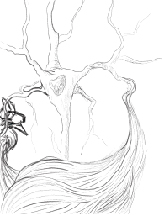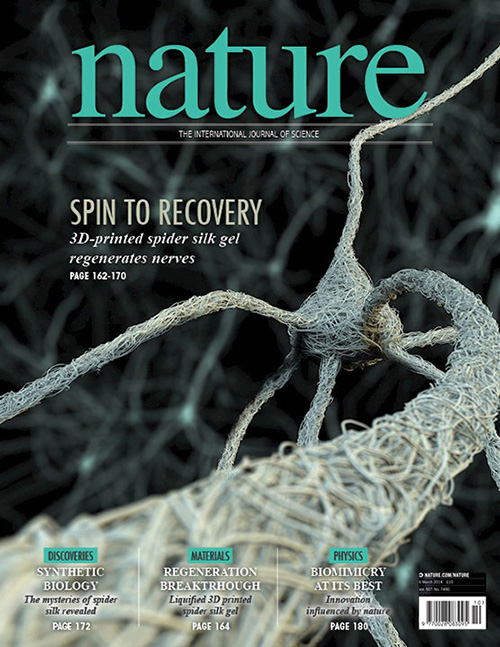Spin to Recovery
- Media:
- MAXON Cinema 4D, Adobe Photoshop, Adobe InDesign
- Target Audience:
- Scientific audience
- Format:
- Supervisor:
- Prof. Nick Woolridge, Biomedical Communications, University of Toronto
- Purpose:
- To entice scientific audience into reading the feature article about recent discoveries in the relationship between protein structure and physical properties of spider silk and its application in regenerative medicine and biomedical engineering.
- Award:
- Association of Medical Illustrators Award of Merit for the Student Editorial Category - 2015.
INSPIRATION
Scientists were able to generate an extremely strong and flexible biomaterial by mixing recombinantly produced spider silk proteins with fibroblast as well as living cells that could then be used as 3D printer bio-ink. The illustration was to provide a visual depiction of the spider silk’s extraordinary properties of high tensile strength and toughness as well as the ability to twist and extend.
PROCESS WORK


3D models were created in Cinema4D. MoDynamics were used to dynamically fill the structure of the neuron with spidersilk. The goal was for the structures to closely resemble the biomaterial while visually appearing as a neuron. The background neurons were based on human neuronal morphological data from NeuroMorpho.Org. A depth pass was set up in Cinema4D for rendering depth of field and applied to the image in Adobe Photoshop.

References:
Ascoli GA, Donohue DE, Halavi M. (2007) NeuroMorpho.Org: a central resource for neuronal morphologies.J Neurosci., 27(35):9247-51
Doblhofer, E., Heidebrecht, A. and Scheibel, T. To spin or not to spin: spider silk fibers and more. Appl. Microbiol. Biotechnol. 99: 9361-9380. doi: 10.1007/s00253-015-6948-8
Hayes, T. L., and D. A. Lewis. 1996. Magnopyramidal neurons in the anterior motor speech region. dendritic features and interhemispheric comparisons. Archives of Neurology 53 (12) (Dec): 1277-83.
Heidebrecht, A., Eisoldt, L., Diehl, J., Schmidt, A., Geffers, M., Lang, G. and Scheibel, T. Biomimetic fibers made of recombinant spidroins with the same toughness as natural spider silk. Adv. Mater., 27: 2189–2194. doi: 10.1002/adma.201404234
Jacobs, B., M. Schall, M. Prather, E. Kapler, L. Driscoll, S. Baca, J. Jacobs, K. Ford, M. Wainwright, and M. Treml. 2001. Regional dendritic and spine variation in human cerebral cortex: A quantitative golgi study. Cerebral Cortex (New York, N.Y.: 1991) 11 (6) (Jun): 558-71.
Watson, K. K., T. K. Jones, and J. M. Allman. 2006. Dendritic architecture of the von economo neurons. Neuroscience 141 (3) (Sep 1): 1107-12.
